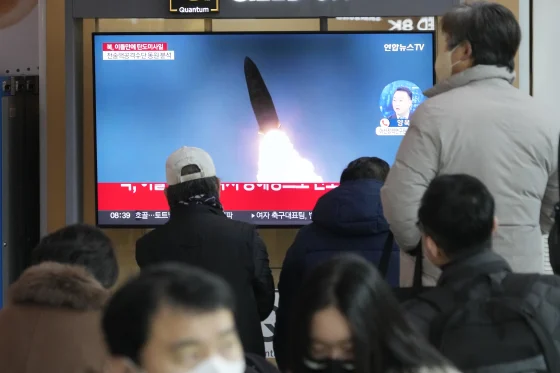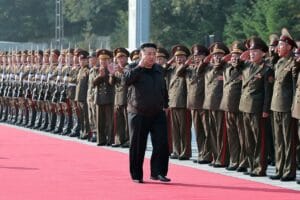The firing of two short-range missiles followed the launch Saturday of an intercontinental ballistic missile, prompting U.S. joint military drills with South Korea and Japan.
SEOUL, South Korea — North Korea fired two short-range ballistic missiles toward Japan on Monday in its second weapons test in three days, prompting Tokyo to call for an emergency meeting of the United Nations Security Council.
The missiles were fired around 7 a.m. (5 p.m. Sunday ET) from a town on North Korea’s west coast just north of the capital, Pyongyang, according to South Korea’s Joint Chiefs of Staff. They flew 210 to 250 miles at a maximum altitude of 30 to 60 miles before they landed off the west coast of Japan. Japan said that both missiles landed outside its exclusive economic zone and that no damage had been reported to aircraft or vessels in the area.
Japan and South Korea condemned the launches as violations of U.N. Security Council resolutions, and Japan said it had lodged a protest through its embassy in Beijing. Japanese Prime Minister Fumio Kishida told reporters that Tokyo had requested an emergency Security Council meeting.
“North Korea’s series of actions threaten the peace and security of our country, the region and also the international community, and they are absolutely unacceptable,” Hirokazu Matsuno, Japan’s chief cabinet secretary, said at a news briefing.
Matsuno said the Japanese government expected North Korea to continue to conduct missile tests, as well as a possible seventh nuclear test, which would be its first since 2017.
Over the weekend, North Korea launched an intercontinental ballistic missile.
A record series of North Korean missile tests since last year, including tests of ICBMs, has significantly raised tensions on the Korean Peninsula and in the broader region. The U.S. and its allies South Korea and Japan have responded by expanding joint military drills that the North decries as a rehearsal for invasion, which the U.S. and other militaries deny.
On Friday, North Korea threatened “unprecedently” strong action against the U.S. and South Korea over planned joint military exercises. The next day, the North fired a Hwasong-15 ICBM in what it called a “sudden launching drill.”
In response to the weapons test Saturday, North Korea’s first since Jan. 1, the U.S. military held bilateral air drills with South Korea and Japan on Sunday that involved strategic bombers.
The U.S. Indo-Pacific Command said in a statement that the additional ballistic missile launches Monday “highlight the destabilizing impact” of North Korea’s unlawful weapons programs. It said the launches did not pose an immediate threat to U.S. personnel or territory and that the U.S. commitments to the defense of South Korea and Japan “remain ironclad.”
North Korea said the drill involved its 600 mm multiple-rocket launcher system and simulated strikes on targets up to 245 miles away. The launches demonstrated the Korean People’s Army’s “full readiness to deter and will to counter” U.S. and South Korean forces, according to North Korean state media.
In a statement after the launches, Kim Yo Jong, the powerful sister of North Korean leader Kim Jong Un, warned U.S. forces to halt military drills.
“The frequency of using the Pacific as our firing range depends upon the U.S. forces’ action character,” she said in a statement carried by North Korean state media.
It followed a similar statement in which she said Sunday that North Korea would take “overwhelming counteraction” against any perceived direct or indirect threat.
Kim Yo Jong also defended the North’s missile technology and capabilities, citing South Korean reports that it had taken more than nine hours for North Korea to launch the ICBM on Saturday after the written order was made.
Recent statements out of Pyongyang have shown disdain for international skepticism about North Korea’s weapons technology, said Leif-Eric Easley, a professor of international studies at Ewha Womans University in Seoul.
“The Kim regime’s claims of short-notice launches are thus intended to demonstrate not only the development of strategic and tactical nuclear forces, but also the operational capability to use them,” he said in an email.
The ICBM launch came a day after Kim took his daughter to a sports event in the first time she has been seen in a nonmilitary setting. The girl, who is believed to be about 10 years old and named Kim Ju Ae, has made a number of public appearances since last year, although South Korea says it is too early to determine whether she is being groomed as her father’s successor.
The sports event Friday was held in celebration of a national holiday marking the birthday of Kim’s father and predecessor, the late Kim Jong Il. The ICBM test on Saturday may have been another way of honoring the elder Kim, in addition to backing up North Korean threats over U.S.-South Korean military cooperation, Easley said.
Kim has been developing his weapons programs even as North Korea faces serious food shortages, a situation South Korea said last week appears to have worsened.
source: nbc










